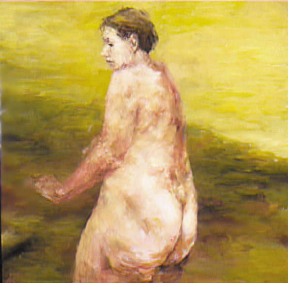Girls Girls Girls
Nude 2002's traditional offerings of the female form
By John Norris

Residual, by Yvonne Petkus
Nude 2002, opening this weekend at the Loudoun House, offers for the most part a collection of the kind of polished, idealized homages to the female form which seem to have become a staple for this annual exhibition.
The juror, Sharon Hunter, Vice President of Academic Affairs at the Lyme Academy of Fine Arts professes to have sought "a balance between technical expertise and self-expression." While the technical expertise element seems to take a more notable hold (mostly in the form of the previously mentioned slick portrait paintings of the kind of women that really only exist inwell slick portrait paintings), there are a number of works that do project a distinct sense of expression while also upholding that time honored monument of "technical proficiency" upon which the nude has been hanging its hat for centuries.
One of the few truly Modernist readings of the figure can be found in Gordon Gildersleeve's steel sculpture, The Dancer. This piece instantly brings to mind the work of artists such as Constantin Brancusi and Jean Arp, but it differs from the figurative works of these artists by fragmenting the figure exactly opposite of how they worked. While Brancusi and Arp tended to concentrate on either the head or appendages like the arms or phallis, Gildersleeve concentrates on the legs and torso, creating a reading of the figure as a kind of fleeting trunk which begins with a single point at the base and slowly expands as an elegant S-curve follows the legs up through the torso and finally breaks at the encounter of the shoulder.
Randy Simmons' Elisabeth II offers a second instance of this marriage of technique and expression. This large-scale charcoal adheres to the school of thought drifting throughout contemporary realism which claims drawing not as merely a preparation for future endeavors (i.e., painting), but as capable of standing on its own as a finished work. The other interesting thing about Simmons' drawing is the apparent influence of photography on his sense of light and scale. Like contemporary figurative icon Alfred Leslie, Simmons' preference for artificial light and employment of certain distortions created by the camera lend the understanding that, while presented in a traditional medium, this is a work that could not have been created, say, 200 years ago.
But where Leslie's figures tend to exude a sense of frankness and kind of proud indifference to the viewer, Simmons' subject is obviously sharing an instance of intimacy and thus creates an atmosphere of welcomed vulnerability. Simmons does well to build up form through successive layers of hatching and by dragging the charcoal in a manner which highlights the tooth of the textured paper.
In many ways, the piece which best attains our decided aspiration of the technicality/expression combination would have to be Residual, an oil by Yvonne Petkus. This work combines an unidealized view of the female form with a visceral exploration of thick, wet-in-wet painting. Petkus' handling of the figure, as a celebration of the very tendencies of skin and flesh that most sitters hope one will avoid, is reminiscent of Jenny Saville's huge paintings of similarly grand women showing off their abundance of being by doing things like pressing it up against glass.
Petkus acutely portrays the great variety of skin tone one encounters in the nude; the deep reds of the sun-weathered forearms give way to the less exposed torso and ultimately to a pale buttocks that may be seeing the light of the sun for the first time. The setting presents itself as a vaguely abandoned landscape at either dawn or daybreak. This environment, when combined with the figure's gaze towards something apparently disturbing and just outside of the picture frame, reminds one of the eerily empty landscapes of Odd Nerdrum, in which equally disturbed figures seem to be engaged in the equivalent of a post-apocalyptic meditation. For Nerdrum, these environments might indicate the isolation of a traditionalist trying to navigate through the irony-infested wasteland of contemporary painting. For Petkus, however, it seems to provide some notion of how rare this type of representation of the female form truly is.
Perhaps the most rewarding quality of her painting, however, is simply Petkus' confident handling of paint. Working wet-in-wet with richly impastoed paint, it seems as if every single mark is visible and describes some aspect of the figure, be it to describe the rigidity of the structure or the softness of the flesh. It's also nice to be able to discern the artist's purposeful use of different sized brushes.
So as you walk through the opening at the Loudon House this weekend with your glass of Shiraz in hand, take a minute to step back from the fantasies of conventional portrait painting and search for the figure that stands as alone in the exhibition as it does in its pale ochre landscape. That's where I'll be anyways.
This year's installation of the Lexington Art League's Juried Nude exhibition will be the last to be held at the Loudoun House Gallery for at least a year, as the house will begin a year-long renovation project at the conclusion of this exhibit.